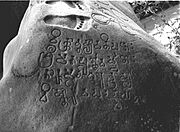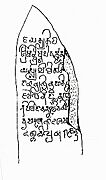Pallava script facts for kids
Quick facts for kids Pallava script |
|
|---|---|

'Pallava' in Pallava script
|
|
| Type | Abugida |
| Spoken languages | Tamil, Old Khmer, Old Malay, Burmese, Thai, Sri Lankan Sinhala, Lao, Mon, Balinese, etc. |
| Time period | 4th century CE to 8th century CE |
| Parent systems | |
| Child systems | Tamil, Grantha, Mon-Burmese, Khmer, Cham, Kawi |
| Sister systems | Vatteluttu |
| Note: This page may contain IPA phonetic symbols in Unicode. | |
The Pallava script or Pallava Grantha is a Brahmic script named after the Pallava dynasty of Southern India (Tamilakam) and is attested to since the 4th century CE. In India, the Pallava script evolved from Tamil-Brahmi. The Grantha script originated from the Pallava script. Pallava also spread to Southeast Asia and evolved into scripts such as Balinese, Baybayin, Javanese, Kawi, Khmer, Lanna, Lao, Mon–Burmese, New Tai Lue, Sundanese, and Thai.
Epigrapher Arlo Griffiths argues that the name of the script is misleading as not all of the relevant scripts referred to have a connection with the Pallava dynasty. He instead advocates that these scripts be called Late Southern Brāhmī scripts.
History
During the rule of Pallavas, the script accompanied priests, monks, scholars, and traders into Southeast Asia. Pallavas developed the Pallava script based on the Tamil-Brahmi. The main characteristics of the newer script are aesthetically matched and fuller consonant glyphs. Similar to Pallava script, also visible in the writing systems of Chalukya, Kadamba, and Vengi at the time of Ikshvakus. Brahmi's design was slightly different from the scripts of Cholas, Pandyas, and Cheras. Pallava script was the first significant development of Brahmi in India, combining rounded and rectangular strokes and adding typographical effects, and was suitable for civic and religious inscriptions. Kadamba-Pallava script evolved into early forms of Kannada and Telugu scripts. Glyphs become more rounded and incorporate loops because of writing upon leaves and paper.
The script is not yet a part of Unicode but proposals have been made to include it. In 2018, Anshuman Pandey made a proposal.
Characteristics
The form shown here is based on examples from the 7th century CE. Letters labeled * have uncertain sound value, as they have little occurrence in Southeast Asia.
Consonants
Each consonant has an inherent /a/, which will be sounded if no vowel sign is attached. If two consonants follow one another without intervening vowel, the second consonant is made into a subscript form, and attached below the first.
| ka | kha | ga | gha | nga |
|---|---|---|---|---|
| ca | cha | ja | jha* | nya |
| ṭa | ṭha* | ḍa | ḍha* | ṇa |
| ta | tha | da | dha | na |
| pa | pha | ba | bha | ma |
| ya | ra | la | va | |
| śa | ṣa | sa | ha | |
Independent Vowels
| a | ā | i | ī | u | e | o | ai* | au* |
|---|---|---|---|---|---|---|---|---|
Examples
-
Pallava script at the 8th century Kailasanatha temple in Kanchipuram, Tamil Nadu.
-
The Ciaruteun inscription, a 5th-century Pallava stone inscription discovered in Indonesia
-
One of the oldest inscriptions discovered in Indonesia, the Yūpa inscriptions of King Mulavarman, king of Kutai Martadipura written in the 4th century AD
Unicode
A proposal to encode the script in Unicode was submitted in 2018.





